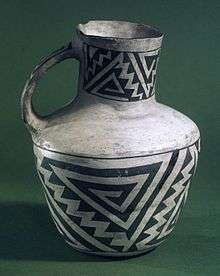Pitcher (container)
.svg.png)
In US English, a pitcher is a container with a spout used for storing and pouring contents which are liquid in form. In English speaking countries outside North America, a jug is any container with a handle and a mouth and spout for liquid—American "pitchers" are more likely to be called jugs elsewhere. Generally a pitcher also has a handle, which makes pouring easier. A ewer is a vase-shaped pitcher, often decorated, with a base and a flaring spout, though the word is now unusual in informal English describing ordinary domestic vessels.[1] An example of a ewer is the America's Cup given to the winner of the America's Cup sailing regatta match.[2]
Etymology

The word "pitcher" comes from the 13th century Middle English word picher, which means earthen jug.[3][4] The word picher is linked to the Old French word pichier which is the altered version of the word bichier, meaning drinking cup.[5] The pitcher’s origin goes as far back to the Medieval Latin word bicarium from the Greek word bikos, which meant earthen vessel. Compare with Dutch beker, German Becher and English beaker.
Early recording

An early mention of a pitcher was when the Biblical Book of Genesis mentions of Rebekah coming to Abraham's servant bearing a vessel with water.[6] Another excerpt from the Bible mentions empty pitchers with lamps given by Gideon to three hundred men divided into three companies, in the Book of Judges.[7] In the Gospels of Mark and Luke, Jesus told two of his disciples to go into the city of Jerusalem where they would meet a man carrying a pitcher of water (Greek: κεράμιον ὕδατος), and they were to follow him to locate the upper room to be used for the Last Supper.[8]
Other religions have been known to use such water vessels, one of which is the notable Pitcher of Marwan Ibn Mohammad which predates 8th century AD. The artifact was acquired and unearthed by archeologists on May 15, 1930, currently it is on display at the Museum of Islamic Art in Cairo, Egypt.[9][10]
Ewers were also popular works of art during the Tang Dynasty in China. Commonly associated with forms of glazed earthenware, these ewers bore illustrations inspired by trading along the Silk Road of Persian textiles and metal work as well as increased cultural diversity in populated Chinese cities, such as Chang'an. These items once coveted by the upper classes of China became commonplace artifacts regardless of socioeconomic status.[11]
Idiomatic usage
"Little pitchers have big ears" is a proverb.[12] The phrase depicts a child as the pitcher with ears hearing what people around them say or do, which is stored inside. The adults are also cautioned that the children might not be as naïve as they are perceived to be.[13]
See also
References
- ↑ "ewer". Merriam-Webster. Retrieved 17 March 2010.
- ↑ An overall account can be found the book by John Rousmaniere (1983). The America's Cup 1851–1983. Pelham Books. ISBN 978-0-7207-1503-3.
- ↑ "pitcher". Merriam-Webster Online Dictionary. Retrieved 17 March 2010.
- ↑ Douglas Harper. "pitcher". Retrieved 17 March 2010.
- ↑ "Word Origin & History". Word Origin & History. Retrieved 17 March 2010.
- ↑ "Genesis 24:15". The Bible. Retrieved 17 March 2010.
- ↑ "Judges 7:16". The Bible. Retrieved 17 March 2010.
- ↑ Mark 14:13; Luke 22;10
- ↑ "About: Pitcher of Marawan Ibn Mohammad". Eternal Egypt. Retrieved 25 March 2010.
- ↑ "Pitcher of Marawan Ibn Mohammad". Eternal Egypt. Retrieved 25 March 2010.
- ↑ Birmingham Museum of Art (2010). Birmingham Museum of Art : guide to the collection. [Birmingham, Ala]: Birmingham Museum of Art. p. 24. ISBN 978-1-904832-77-5.
- ↑ "Idiom: Little pitchers have big ears". Using English.com. Retrieved 17 March 2010.
- ↑ "little pitchers have big ears". Dictionary.com, LLC. Retrieved 17 March 2010.
External links
| Look up pitcher in Wiktionary, the free dictionary. |
| Wikimedia Commons has media related to Pitchers. |